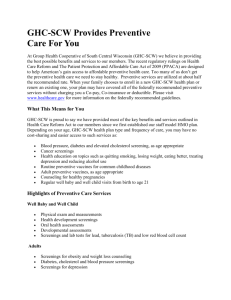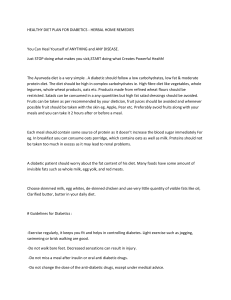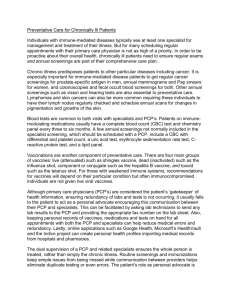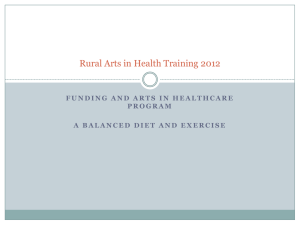Preventative Health Quick Start Guide
advertisement
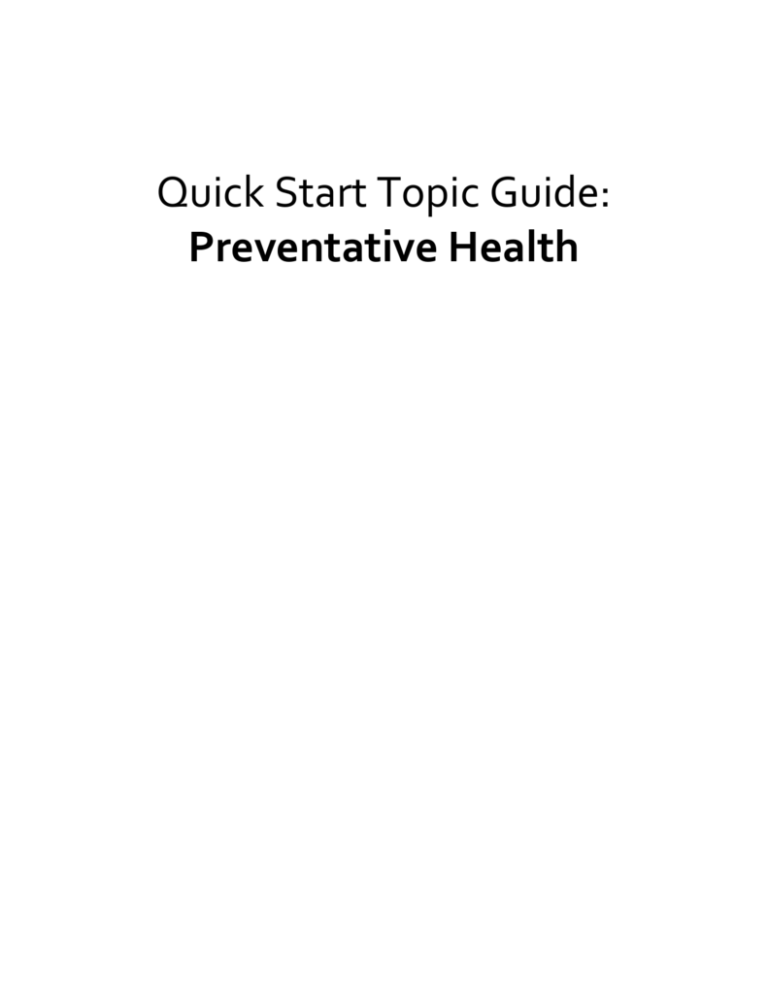
Quick Start Topic Guide: Preventative Health Contents Introduction ................................................................................................................. 3 Overview Healthy Lifestyle ....................................................................................................... 3-4 Diet Exercise Tests and Screenings ................................................................................................. 4-5 Blood Pressure and Cholesterol Tests Diabetes Tests Cancer Screening Vaccinations ................................................................................................................ 5 Flu and Pneumonia Shots Routine Vaccines How to Get Involved ..................................................................................................... 6 Diet Exercise Vaccinations Sample Activities ......................................................................................................... 7 Healthy Cooking Class Field Day Page | 2 Introduction Overview Preventive health care is a right that few Americans take full advantage of. However, it is an important part of maintaining a healthy life. Healthy is not simply the absence of disease. It is an affirmatively positive state of being. Preventive health is a key to attaining this healthier state and living a happier life. Daily steps can be taken to maintain a healthy lifestyle, with diet and exercise being two of the most important. In addition to that, there are a variety of tests and screenings that can be done by a doctor on a regular basis to catch and prevent serious diseases. Disease prevention is also sustained by routine vaccinations. All of these small steps can lead to a healthier, happier life! You can get involved in preventative care for your community by becoming an advocate in your community and promoting preventative health. You can get involved in preventative care for your family encouraging family and loved ones to engage in preventative behaviors. You can take charge of your own preventative care by applying the topics discussed to your daily life and health behaviors. Healthy Lifestyle Diet Having a well balanced, healthy diet provides your body with the necessary vitamins and minerals needed to perform daily functions. The body is an amazing thing, but it needs the proper fuel! This means eating meals that are balanced with the necessary servings of fruits, vegetables, protein, grains, and dairy. There are two barriers that generally to people reaching the necessary servings of each of these food groups: personal choices and inaccessibility. Personal Choice o Although there is nothing wrong with indulging in sweets from time to time, it is important that these are not an integral part of your diet and that your diet is still well balanced with foods from the basic food. Page | 3 Inaccessibility o For millions of Americans, however, a balanced diet is not attainable. About 49 million (33.1 million adults and 15.9 million children) live in food insecure households. Food insecurity takes away the choice of healthy versus not health foods and leaves individuals with the choice of eating versus going hungry. Exercise Engaging in daily physical activity is an important way to keep your muscles strong, your heart healthy, and your brain active. This does not necessitate joining a sports team or getting a gym membership although those are great ways to stay active. There are simply everyday ways to get moving without necessitating a great deal of commitment. Physical activity includes a variety of activities that a person might choose to perform on a daily basis: walking, gardening, dancing, or even doing housework. More intense activities, such as running, cycling, and engaging in sports, are wonderful ways to keep in peak physical form. Small changes such as taking the stairs instead of the escalator and parking further away from the entrance in a parking lot can add extra movement to your life and keep your body healthy. Tests and Screenings Blood Pressure and Cholesterol Tests Even if someone does not have visible signs of illness, their bodies might be experiencing unfavorable conditions, including high blood pressure or cholesterol levels. Regular doctors’ visits decrease the likelihood of individuals living with these conditions for extended periods of time by testing for these issues. . Early detection allows for critical lifestyle changes to occur and helps avoid alternate negative outcomes, such as heart attacks and strokes. Diabetes Test Diabetes testing is another important preventive measure to take. Testing is particularly important if there is a family history of diabetes. Complications with untreated or poorly treated diabetes can lead to amputation and even blindness. Early detection is the key to properly treating diabetes. Page | 4 Cancer Screening Cancer screening is generally considered to be of greater importance in older years, but cancer can affect people of all ages. For young women, mammograms and personal breast examination can help to catch cancer in its earlier stages. Prostate cancer screenings, although performed less frequently, are effective preventive tools for males. Cancer screening is also very important for individuals with a history of cancer in their family. Vaccinations Flu and Pneumonia Shots Getting vaccinated not only keeps you from getting sick, but it helps to halt the spread of the virus. Vaccinations have the potential to save lives by preventing common communicable diseases. This is especially true with the elderly and the very young, which are generally at higher risk of developing complications from these illnesses. Routine Vaccines Vaccines help reduce the risk of a variety of diseases that might have been unpreventable in the past. One prime example of risk reduction by vaccination is cancer risk. The human papillomavirus (HPV) vaccine helps prevent most cervical cancers and some vaginal and vulvar cancers, and the hepatitis B vaccine can help reduce liver cancer risk. These are just two examples of a variety of vaccines that are available to protect people against diseases. Page | 5 How to Get Involved Diet National Organizations o Feeding America (feedingamerica.org) A hunger-relief charity that aims to feed America’s hungry through a nationwide network of member food banks as well as to engage our country in the fight to end hunger Local Actions o Start a community garden o Repack donated food for use at food pantries Exercise National Organizations o President’s Challenge (presidentschallenge.org) A program by the President’s Council on Fitness, Sports, and Nutrition to help people of all ages and abilities increase their physical activity and improve their fitness. Local Actions o Volunteer at an after-school program Vaccinations National Organizations o Voices for Vaccines (voicesforvaccines.org) A parent-initiated organization dedicated to raising awareness about vaccines and their important role in disease prevention. Local Actions o Volunteer at a local free-clinic Page | 6 Sample Activities Healthy Cooking Class Teach how to make a few healthy recipes at a local community center or school. Explain the health benefits of various ingredients, and hand out samples/copies of the recipe at the end of class! Establishing good eating habits by eating nutritious, healthy foods can go a long way in preventive health. Field Day Help establish or volunteer for a field day at the park with a local school. Include various games that get kids on their feet and moving! This can portray being active as “fun” as well as making their bodies stronger and healthier! Page | 7
